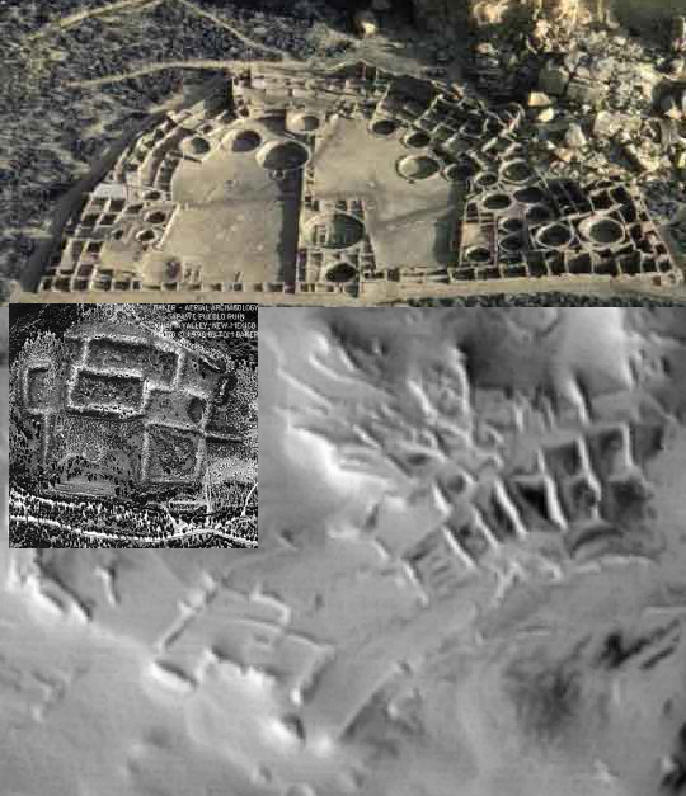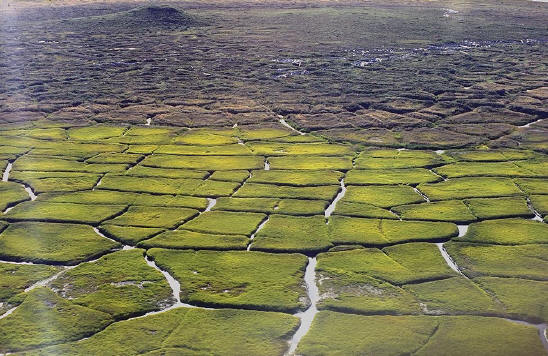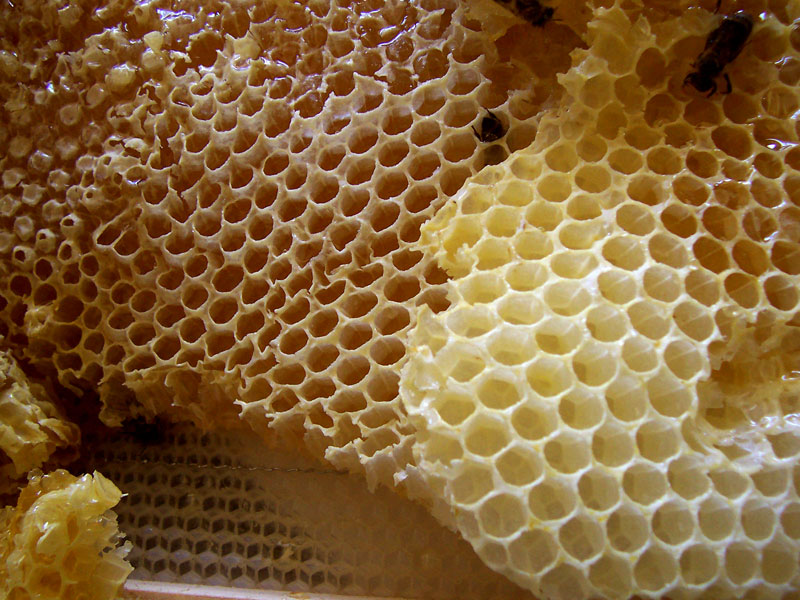It looks like you're using an Ad Blocker.
Please white-list or disable AboveTopSecret.com in your ad-blocking tool.
Thank you.
Some features of ATS will be disabled while you continue to use an ad-blocker.
share:
NASA Orbiter Snaps Image Of Mysterious "Honeycomb" On The Surface Of Mars
www.iflscience.com...

Now this is pretty cool! When I first read "honeycomb" I was like this has to be alien architecture. Seeing the picture, yeah, wind erosion came to mine (and maybe environmental changes too).
Either way a cool new find on the red planet. Hope to see more cool and interesting things on there
Additional Notes:
Found another honeycomb-like structure on Mars...this time known as "Inca City"...as comparison to on Earth:

www.enterprisemission.com...
And someone on this The Enterprise Mission website made this comparison:

...to this...

So to me...this kind of gives it the honeycomb appearance. Took me a while to kind of look into it but whoever made the comparison above looked to be pretty darn close.
www.iflscience.com...

An image from NASA’s Mars Reconnaissance Orbiter (MRO) has revealed intriguing honeycomb-textured features in a region of the Red Planet.
The image was taken by the HiRISE camera on the MRO, and it’s looking towards the northwestern Hellas Planitia, one of the largest and most ancient impact basins on Mars.
“Honeycombs” here is a reference to rectangular ridges that are unique to the Red Planet. They’ve been spotted before, but they’re highlighted again in this image.
We’re actually quite zoomed in here, at 50 centimeters (20 inches) per pixel. But if you look at the zoomed out image below, you can clearly see the different honeycomb-like sections. They measure about 5 to 10 kilometers (3 to 6 miles) across.
“Scientists have been debating how these honeycombed features are created, theorizing from glacial events, lake formation, volcanic activity, and tectonic activity, to wind erosion,” said NASA.
It’s thought the feature may be in part formed by wind erosion, as the walls of the cells look a bit like ripples of sand. The bedrock has also been exposed in the floor and walls of the cells, which can be the result of volcanic activity.
The cells are notable in another way too, namely that they have a lack of impact craters. This suggests they have been recently reshaped by one of the processes mentioned above.
Honeycombs were first spotted on Mars back in 1972, leading to numerous conspiracy theories about Martian cities. Now that we can see them more closely, of course, we can tell that they are natural features. But they’re still fascinating, all the same.
Now this is pretty cool! When I first read "honeycomb" I was like this has to be alien architecture. Seeing the picture, yeah, wind erosion came to mine (and maybe environmental changes too).
Either way a cool new find on the red planet. Hope to see more cool and interesting things on there
Additional Notes:
Found another honeycomb-like structure on Mars...this time known as "Inca City"...as comparison to on Earth:

www.enterprisemission.com...
And someone on this The Enterprise Mission website made this comparison:

...to this...

This is an example of typical frost wedging here on Earth. The forms are caused by repetitive freeze and thaw over many years. The ground eventually forms cracks, or weak points, sometimes in vaguely polygonal patterns like you see above. The melting snows find their way into these fissures, slowly wearing away the ground in between the harder blocks and creating water filled channels for runoff. This is a slow process, and as you can see the wedges are very shallow. But the important thing to remember is that the softer soil is pushed away by the flowing waters, which eventually shapes the harder stuff into the polygonal forms we see above. In other words, the runoff flow creates the shapes.
So to me...this kind of gives it the honeycomb appearance. Took me a while to kind of look into it but whoever made the comparison above looked to be pretty darn close.
edit on 30-11-2017 by Skywatcher2011 because: Added notes
a reply to: Skywatcher2011
On the left side I see an alien with a scorpion over his head spitting poison at the alien head......
Do I win?.....or should I cut back on the pain killers a little?
On the left side I see an alien with a scorpion over his head spitting poison at the alien head......
Do I win?.....or should I cut back on the pain killers a little?
I remember seeing these formations before.
Of course stereotypical environmental effects, but pretty cool looking nonetheless.
Of course stereotypical environmental effects, but pretty cool looking nonetheless.
originally posted by: butcherguy
a reply to: Skywatcher2011
Which part of the photo do I need to zoom in on to see the honeycomb?
Here is a picture of a honeycomb...let this be your guide to figure it out!

a reply to: Skywatcher2011
It does share a resemblance to ancient ruins located on earth.
Interesting find.
It does share a resemblance to ancient ruins located on earth.
Interesting find.
originally posted by: Xcathdra
a reply to: Skywatcher2011
It does share a resemblance to ancient ruins located on earth.
Interesting find.
Does it really? Let me do a quick check.....
Added Note:
Inca City? See OP
edit on 30-11-2017 by Skywatcher2011 because: added note
originally posted by: stosh64
a reply to: Skywatcher2011
On the left side I see an alien with a scorpion over his head spitting poison at the alien head......
Do I win?.....or should I cut back on the pain killers a little?
Nope. Seems like you found the perfect dose.
a reply to: Skywatcher2011
Using the guide that you provided, I am still having trouble finding a grid consisting of hexagonal cells.
Using the guide that you provided, I am still having trouble finding a grid consisting of hexagonal cells.
originally posted by: Skywatcher2011
originally posted by: butcherguy
a reply to: Skywatcher2011
Which part of the photo do I need to zoom in on to see the honeycomb?
Here is a picture of a honeycomb...let this be your guide to figure it out!
Yeah, I don't see it either and based on OP's snarky and unhelpful remark, it's probably not discussion worthy!!
originally posted by: Human_Alien
originally posted by: Skywatcher2011
originally posted by: butcherguy
a reply to: Skywatcher2011
Which part of the photo do I need to zoom in on to see the honeycomb?
Here is a picture of a honeycomb...let this be your guide to figure it out!
Yeah, I don't see it either and based on OP's snarky and unhelpful remark, it's probably not discussion worthy!!
I am sorry I didn't mean to sound offensive or rude. I had a playful way of trying to say use your imagination and creativity to come up with a comparison on what you see or observe. I saw the honeycomb in an instant!
On no it doesn't! Oh Yes it doesn't!
originally posted by: Skywatcher2011
originally posted by: Xcathdra
a reply to: Skywatcher2011
It does share a resemblance to ancient ruins located on earth.
Interesting find.
Does it really? Let me do a quick check.....
originally posted by: seasonal
a reply to: Skywatcher2011
I couldn't help myself.
S+F
Too funny...but honeycomb is a honeycomb Either way you look at it, it goes with the theme headline.
originally posted by: Xcathdra
It does share a resemblance to ancient ruins located on earth.
Sort of. Humans are apparently much better at making something approximating right angles, and they also leave spaces in the walls for doors so the rooms can actually be used.
originally posted by: mikos123
a reply to: Skywatcher2011
is this related to a dried out water bed?
That could be a possibility among other things.
new topics
-
Gaetz withdraws from attorney general consideration
US Political Madness: 1 hours ago -
Bridgewater Triangle
General Chit Chat: 1 hours ago -
Is Russia Using a New Type of Beam Weapon Against Ukraine?
Weaponry: 2 hours ago -
Here is why Western leaders in NATO have zero fear of nuclear warfare. At all. Zero.
World War Three: 4 hours ago -
International Criminal Court Issues Arrest Warrant For Netanyahu
Breaking Alternative News: 4 hours ago -
racist rant, but she made the arguement to get rid of DEI
US Political Madness: 6 hours ago -
Well we know Putins ICBMs won't fail in their silos
World War Three: 6 hours ago
top topics
-
FEMA Head Admits Agency Skipped 20 Homes with Trump Signs
Mainstream News: 17 hours ago, 19 flags -
Well we know Putins ICBMs won't fail in their silos
World War Three: 6 hours ago, 12 flags -
racist rant, but she made the arguement to get rid of DEI
US Political Madness: 6 hours ago, 9 flags -
International Criminal Court Issues Arrest Warrant For Netanyahu
Breaking Alternative News: 4 hours ago, 8 flags -
Is Russia Using a New Type of Beam Weapon Against Ukraine?
Weaponry: 2 hours ago, 7 flags -
Why isn't Psychiatry involved?
Social Issues and Civil Unrest: 12 hours ago, 4 flags -
Here is why Western leaders in NATO have zero fear of nuclear warfare. At all. Zero.
World War Three: 4 hours ago, 4 flags -
Help in song interpretation
Music: 14 hours ago, 3 flags -
Gaetz withdraws from attorney general consideration
US Political Madness: 1 hours ago, 3 flags -
Bridgewater Triangle
General Chit Chat: 1 hours ago, 2 flags
active topics
-
Gaetz withdraws from attorney general consideration
US Political Madness • 8 • : CriticalStinker -
How can you defend yourself when the police will not tell you what you did?
Posse Comitatus • 99 • : andy06shake -
International Criminal Court Issues Arrest Warrant For Netanyahu
Breaking Alternative News • 30 • : CriticalStinker -
Russia Ukraine Update Thread - part 3
World War Three • 6850 • : andy06shake -
-@TH3WH17ERABB17- -Q- ---TIME TO SHOW THE WORLD--- -Part- --44--
Dissecting Disinformation • 3337 • : Thoughtful3 -
Is Russia Using a New Type of Beam Weapon Against Ukraine?
Weaponry • 8 • : nerbot -
Well we know Putins ICBMs won't fail in their silos
World War Three • 78 • : andy06shake -
Help in song interpretation
Music • 9 • : FullHeathen -
President-elect TRUMP Picks MATT GAETZ for his ATTORNEY GENERAL - High Level PANIC Ensues.
2024 Elections • 117 • : network dude -
racist rant, but she made the arguement to get rid of DEI
US Political Madness • 7 • : KnowItAllKnowNothin
